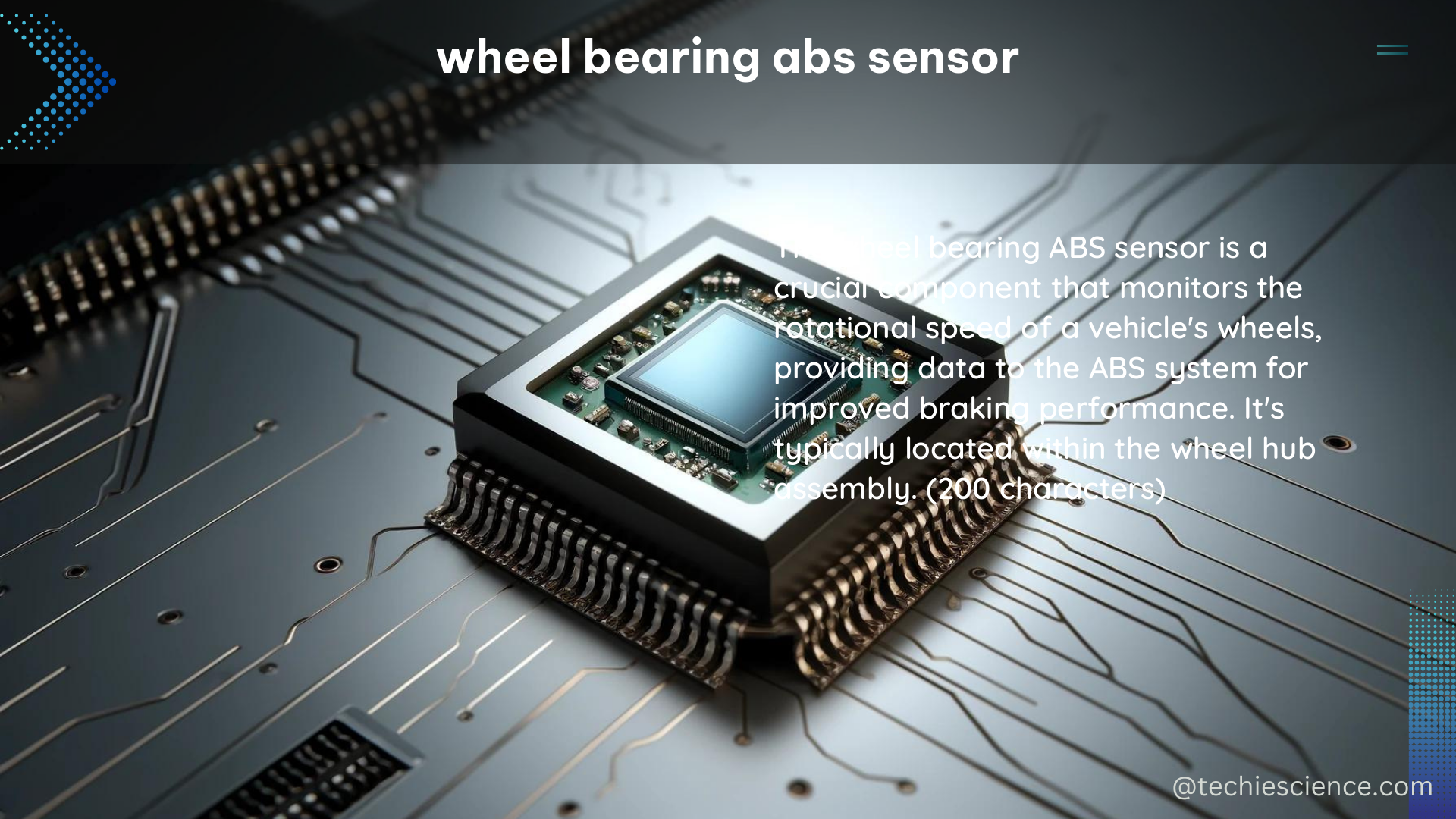The wheel bearing ABS sensor, also known as the wheel speed sensor, is a critical component in modern vehicles’ anti-lock braking systems (ABS). It measures the rotational speed of the wheels and helps prevent the wheels from locking up during braking, ensuring vehicle stability and safety. This comprehensive guide will delve into the technical details and quantifiable data points of the wheel bearing ABS sensor, providing a valuable resource for DIY enthusiasts and automotive professionals alike.
Frequency and Amplitudes
The wheel speed sensor detects the frequency and amplitudes of the alternating voltage induced in the winding, which are directly related to the wheel speed. The frequency of the sensor’s output signal is typically in the range of 0.5 to 2 kHz, with amplitudes ranging from 0.5 to 12 volts, depending on the vehicle’s speed and the sensor’s design. The sensor’s output signal is a sinusoidal waveform, and the frequency of this signal is directly proportional to the wheel’s rotational speed.
Impulse Ring and Magnetic Flow

The impulse ring attached to the brake disc serves as a signaling device for the wheel speed sensor. The impulse ring is a toothed wheel that rotates with the wheel, and as it rotates, the teeth pass by the sensor, causing changes in the magnetic flow. These changes in magnetic flow are then forwarded to the control unit as a signal via the wheel speed sensor. The number of teeth on the impulse ring can vary, but a common range is 40 to 100 teeth, with a typical tooth spacing of 2 to 5 mm.
Sensor Types
Wheel speed sensors can be designed as active or passive sensors. Active sensors require a supply voltage and generate an output signal, while passive sensors operate without an additional supply voltage. Active sensors are typically Hall-effect sensors or magnetoresistive sensors, which use a magnetic field to generate an electrical signal. Passive sensors are usually inductive sensors, which generate a voltage signal due to the changing magnetic field caused by the rotating impulse ring.
| Sensor Type | Supply Voltage | Output Signal |
|---|---|---|
| Active (Hall-effect, Magnetoresistive) | Required | Electrical signal |
| Passive (Inductive) | Not required | Induced voltage |
Installation and Precision
Correct installation of the wheel bearing ABS sensor and associated components is crucial for the sensor’s service life and the proper functioning of the ABS. The sensor must be positioned at a specific distance from the impulse ring, typically between 0.5 to 2.5 mm, to ensure accurate wheel speed detection. Improper installation can lead to sensor failure, false readings, or even damage to the ABS system.
Signal Processing
The ABS control unit processes the signals from the wheel speed sensors to determine the rotational speed of each wheel. Inductive-passive sensors do not require a separate power supply from the control unit, as they generate their own voltage signal. Active sensors, on the other hand, are proximity sensors with integrated electronics that are supplied with a defined voltage from the ABS control unit, typically in the range of 8 to 12 volts.
The control unit compares the wheel speeds and detects any significant differences, which could indicate a wheel is about to lock up. When this occurs, the control unit will selectively apply the brakes to that wheel, preventing it from locking and maintaining vehicle stability and control.
Maintenance and Troubleshooting
Regular inspection and maintenance of the wheel bearing ABS sensor are essential for its longevity and the overall performance of the ABS system. Common issues that may arise include sensor failure, wiring problems, and sensor misalignment. Symptoms of a malfunctioning wheel speed sensor include illumination of the ABS warning light, inconsistent or erratic wheel speed readings, and reduced braking performance.
To troubleshoot wheel bearing ABS sensor issues, technicians may use diagnostic tools to measure the sensor’s output voltage, check for proper resistance values, and ensure the sensor is properly aligned with the impulse ring. Replacement of the sensor may be necessary if it is found to be faulty or damaged.
Conclusion
The wheel bearing ABS sensor is a critical component in modern vehicle safety systems, playing a vital role in preventing wheel lock-up during braking. By understanding the technical details and quantifiable data points of this sensor, DIY enthusiasts and automotive professionals can ensure proper installation, maintenance, and troubleshooting, ultimately enhancing the safety and performance of their vehicles.
References
- Brembo S.p.A., “ANNUAL SUSTAINABILITY REPORT 2022 – Brembo”, 2023-04-20.
- HELLA GmbH & Co. KGaA, “BRAKE DISCS AND WHEEL SPEED SENSORS IN ABS SYSTEMS”, 2022.
- EASA, “Untitled”, 2022.
- ResearchGate, “Sensing and Sensor Fundamentals – ResearchGate”, 2016-07-15.
- HELLA GmbH & Co. KGaA, “Check and change ABS and wheel speed sensors | HELLA”, 2023.

The lambdageeks.com Core SME Team is a group of experienced subject matter experts from diverse scientific and technical fields including Physics, Chemistry, Technology,Electronics & Electrical Engineering, Automotive, Mechanical Engineering. Our team collaborates to create high-quality, well-researched articles on a wide range of science and technology topics for the lambdageeks.com website.
All Our Senior SME are having more than 7 Years of experience in the respective fields . They are either Working Industry Professionals or assocaited With different Universities. Refer Our Authors Page to get to know About our Core SMEs.